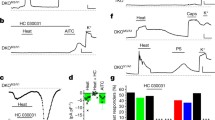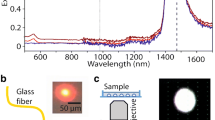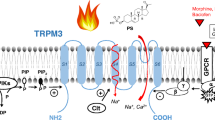Abstract
Mammalian heat pain perception is well documented as a molecular event in the primary afferent neurons expressing TRPV1. Six types of thermo-TRPs were found, i.e., TRPV1–4, TRPM8 and TRPA1. The former TRPV1, 2 and TRPV3, 4 are sensitive to noxious heat and warmth, and the latter two are sensitive to cool or cold, respectively. We attempted to provide a hypothesis to explain the paradox in which TRPV1 knockout mice and capsaicin-pretreated mice with severe loss of small dorsal root ganglion (DRG) neurons behave normally to noxious heat. From the general view that TRPV1 is preferentially expressed in C-fibers responding to a moderate thermal threshold (>43°C) and TRPV2 in Aδ-fibers to high threshold temperatures (>52°C), the above phenomenon is perplexing. Woodbury et al. (J Neurosci 24:6410–6415, 2004) offered two pain transduction mechanisms, one being TRPV1/2-independent and the other TRPV1-dependent. The former detects noxious heat under normal conditions without the presence of TRPV1 or TRPV2, and the latter requires TRPV1 under pathophysiological conditions. Unidentified isolectin B4 (IB4)-positive but TRPV1-negative small neurons with a higher noxious heat threshold are feasible, because a spliced isoform of TRPV1 responsive to noxious heat (47°C) but not responsive to either proton or capsaicin is present in human and rat sensory neurons. Thus, the IB4-positive but TRPV1-negative small sensory neurons must have a crucial role in the noxious heat response.


Similar content being viewed by others
References
Amaya F, Oh-hashi K, Naruse Y et al (2003) Local inflammation increases vanilloid receptor 1 expression within distinct subgroups of DRG neurons. Brain Res 963:190–196
Bandell M, Macpherson LJ, Patapoutian A (2007) From chills to chilis: mechanisms for the thermosensation and chemesthesis via thermo TRPs. Curr Opin Neurobiol 17:490–497
Bennett DLH, Averill S, Clary DO, Priestley JV, McMahon SB (1996) Postnatal changes in the expression of the trkA high-affinity NGF receptor in primary sensory neurons. Eur J Neurosci 8:2204–2208
Brauchi S, Orta G, Salazar M, Rosenmann E, Latorre RJ (2006) A hot-sensing cold receptor: C-terminal domain determinants thermosensation in transient receptor potential channels. Neuroscience 26:4835–4840
Breese NM, George AC, Pauers LE, Stucky CL (2005) Peripheral inflammation selectively increase TRPV1 function in IB4-positive sensory neurons from adult mouse. Pain 115:37–49
Carlton SM, Coggeshall RE (2001) Peripheral capsaicin receptors increase in the inflamed rat hindpaw: a possible mechanism for peripheral sensitization. Neurosci Lett 310:53–56
Caterina MJ (2006) Transient receptor potential ion channels as participants in thermosensation and thermoregulation. Am J Physiol Regul Integr Comp Physiol 292:R64–R76
Caterina MJ, Julius D (2001) The vanilloid receptor: a molecular gateway to the pain pathway. Annu Rev Neurosci 24:487–517
Caterina MJ, Schumacher MA, Tominaga M, Rosen TA, Levine JD, Julius D (1997) The capsaicin receptor: a heat-activated ion channel in the pain pathway. Nature 389:816–824
Caterina MJ, Rosen TA, Tominaga M, Brake AJ, Julius D (1999) A capsaicin-receptor homologue with a high threshold for noxious heat. Nature 398:436–441
Caterina MJ, Leffler A, Malmberg AB et al (2000) Impaired nociception and pain sensation in mice lacking the capsaicin receptor. Science 288:306–313
Davis JB, Gray J, Gunthorpe MJ et al (2000) Vanilloid receptor-1 is essential for inflammatory thermal hyperalgesia. Nature 405:183–187
Dhaka A, Viswanath V, Patapoutian A (2006) TRP ion channels and temperature sensation. Annu Rev Neurosci 29:135–161
Dirajlal S, Pauers LE, Stucky CL (2003) Differential response properties of IB4-positive and -negative unmyelinated sensory neurons to protons and capsaicin. J Neurophysiol 89:513–524
Fang X, Djouhri L, McMullan S et al (2006) Intense isolectin-IB4 binding in rat dorsal root ganglion neurons distinguishes C-fiber nociceptors with broad action potentials and high Nav 1.9 expression. J Neurosci 26:7281–7292
Gavva NR, Klionsky L, Qu Y et al (2004) Molecular determinants of vanilloid sensitivity in TRPV1. J Biol Chem 279:20283–20295
Hiura A, Villalobos EL, Ishizuka H (1992) Age-dependent attenuation of the decrease of C fibers by capsaicin and its effects on responses to nociceptive stimuli. Somatosens Mot Res 9:37–43
Hiura A, Nakagawa H, Koshigae Y, Yoshizako A, Kubo Y, Ishizuka H (1999) Age-related changes in the response to thermal noxious heat and reduction of C-fibers by neonatal treatment with capsaicin. Somatosens Mot Res 16:115–121
Hjerling-Leffler J, AlQatari M, Ernfors P, Koltzenburg M (2007) Emergence of functional sensory subtypes as defined by transient receptor potential channel expression. J Neurosci 27:2435–2443
Holzer P (1991) Capsaicin: cellular targets, mechanisms of action, and selectivity for thin sensory neurons. Pharmacol Rev 43:143–201
Holzer P, Jurna I, Gamse R, Lembeck F (1979) Nociceptive threshold after neonatal capsaicin treatment. Eur J Pharmacol 58:511–514
Jankowski MP, Lawson JJ, McIlwrath SL et al (2009) Sensitization of cutaneous nociceptors after nerve transection and regeneration: possible role of target-derived neurotrophic factor signaling. J Neurosci 29:1636–1647
Jordt SE, Julius D (2002) Molecular basis for species-specific sensitivity to “hot” chili peppers. Cell 108:421–430
Lawson JJ, McIlwrath SL, Woodbury CJ, Davis BM, Koerber HR (2008) TRPV1 unlike TRPV2 is restricted to a subset of mechanically insensitive cutaneous nociceptors responding to heat. J Pain 9:298–308
Leffler A, Monter B, Koltzenburg M (2006) The role of the capsaicin receptor TRPV1 and acid-sensing ion channels (ASIC) in proton sensitivity of subpopulations of primary nociceptive neurons in rats and mice. Neuroscience 139:699–709
Leitner ML, Molliver DC, Osborne PA et al (1999) Analysis of the retrograde transport of glial cell-line derived neurotrophic factor (GDNF), neurturin, and persephin suggests that in vivo signaling for the GDNF family is GFRα coreceptor-specific. J Neurosci 19:9322–9331
Lin Y-W, Min M-Y, Lin CC et al (2008) Identification and characterization of a subset of mouse sensory neurons that express acid-sensing ion channel 3. Neuroscience 151:544–557
Liu M, Willmott NJ, Michael GJ, Priestrey JV (2004) Differential pH and capsaicin responses of Griffonia simplicifolia IB4 (IB4)-positive and IB4-negative small sensory neurons. Neuroscience 127:659–672
Lodish H, Berk A, Ziprusky SL, Matsudaira P, Baltimore D, Darnell J (2000) RNA processing, nuclear transport, and post-transcriptional control. In: Tenney S (ed) Molecular cell biology. W.H. Freeman, New York, pp 425–426
Lu G, Henderson D, Liu L, Reinhart PH, Simon SA (2005) TRPV1b, a functional human vanilloid receptor splice variant. Mol Pharmacol 67:1119–1127
Molliver DC, Wright DE, Leitner ML et al (1997) IB4-binding DRG neurons switch from NGF to GDNF dependence in early postnatal life. Neuron 19:849–861
Nakagawa H, Hiura A (2006) Capsaicin, transient receptor potential (TRP) protein subfamilies and the particular relationship between capsaicin receptors and primary sensory neurons. Anat Sci Int 81:135–155
Patapoutian A, Peier AM, Story GM, Viswanath V (2003) Thermo TRP channels and beyond: mechanisms of temperature sensation. Nat Rev Neurosci 4:529–539
Pingle SC, Matta JA, Ahern GP (2007) Capsaicin receptor: TRPV1. a promiscuous TRP channel. Handb Exp Pharmacol 179:155–171
Priestley JV, Michael GJ, Averill S, Liu M, Willmott N (2002) Regulation of nociceptive neurons by nerve growth factor and glial cell line derived neurotrophic factor. Can J Physiol Pharmacol 80:494–505
Rutter AR, Ma Q-P, Leveridge M, Bonnert TP (2005) Heteromerization and colocalization of TrpV1 and TrpV2 in mammalian cell lines and rat dorsal root ganglia. Neuroreport 16:1735–1739
Siemens J, Zhou S, Piskorowski R et al (2006) Spider toxins activate the capsaicin receptor to produce inflammatory pain. Nature 444:208–212
Streit EJ, Schulte BA, Balentine JD, Spicer SS (1985) Histochemical localization of galactose-containing glycoconjugates in sensory neurons and their processes in the central and peripheral nervous system of the rat. J Histochem Cytochem 33:1042–1052
Stucky CL, Lewin GR (1999) Isolectin B4-positive and -negative nociceptors are functionally distinct. J Neurosci 19:6497–6505
Tarpley JW, Kohler MG, Martin WJ (2004) The behavioral and neuroanatomical effects of IB4-saporin treatment in rat models of nociceptive and neuropathic pain. Brain Res 1029:65–76
Tominaga M, Caterina MJ, Malmberg AB et al (1998) The cloned capsaicin receptor integrates multiple pain-producing stimuli. Neuron 21:531–543
Vulchanova L, Olson TH, Stone LS, Riedl MS, Elde R, Honda CN (2001) Cytotoxic targeting of isolectin IB4-binding sensory neurons. Neuroscience 108:143–155
Winter J, Woolf C, Lynn B (1993) Degenerative and regenerative responses of sensory neurones to capsaicin-induced damage. In: Wood JN (ed) Capsaicin in the study of pain. Academic Press, London, pp 139–140
Woodbury CJ, Zwick M, Wang S et al (2004) Nociceptors lacking TRPV1 and TRPV2 have normal heat responses. J Neurosci 24:6410–6415
Xue Q, Yu Y, Trilk SL, Jong BE, Schumacher MA (2001) The genomic organization of the gene encoding the vanilloid receptor: evidence for multiple splice variants. Genomics 76:14–20
Zimmermann K, Leffler A, Fischer MMJ, Messlinger K, Nau C, Reeh PW (2005) The TRPV1/2/3 activator 2-aminoethoxydiphenyl borate sensitizes native nociceptive neurons to heat in wildtype but not TRPV1 deficient mice. Neuroscience 135:1277–1284
Author information
Authors and Affiliations
Corresponding author
Rights and permissions
About this article
Cite this article
Hiura, A. Is thermal nociception only sensed by the capsaicin receptor, TRPV1?. Anat Sci Int 84, 122–128 (2009). https://doi.org/10.1007/s12565-009-0048-8
Received:
Accepted:
Published:
Issue Date:
DOI: https://doi.org/10.1007/s12565-009-0048-8




